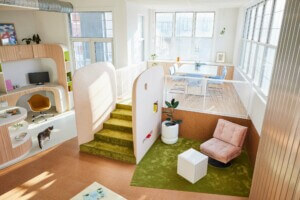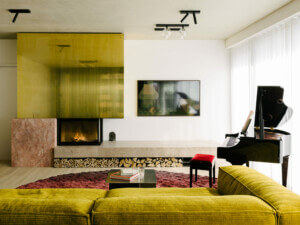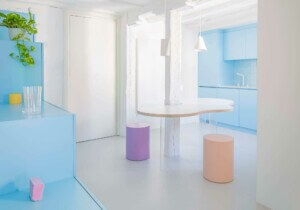Apartments currently represent one of the most fruitful sites of invention within the field of architecture. The contemporary world, simply put, is filled with provocative apartment buildings. Michael Webb’s Building Community—New Apartment Architecture aims to chronicle some of those exemplary projects, delivering a well-rounded—though somewhat incomplete—exploration of contemporary apartment design.
At 256 pages, the tome, with muted graphic design by Praline, is jam-packed with 30 smart apartment designs from across the world designed by renowned firms, including Zaha Hadid Architects, Studio Gang, Michael Maltzan Architecture, Gehry Partners, and Bjarke Ingels Group. The book uses photographs, plans, sections, and other drawings to provide unvarnished views into the ways in which communality functions at the scale of multifamily housing. The collection offers a “greatest hits” approach to uncovering what’s possible when designers and developers work together toward the shared aims of livability and sociability, touching on widely publicized projects like Morphosis Architects’ Carabanchel Housing and Luciano Pia’s 25 Verde. The latter features 150 trees along its exterior, while the former utilizes a network of plazas and courtyards to create cool and social outdoor spaces.
Another stellar example comes in the form of Jakob + MacFarlane Hérold apartments in Paris, from 2008. The chiseled, ETFE-wrapped housing blocks—“softly-molded and irregular,” in Webb’s words—are designed with multiple exposures for cross ventilation and dwelling-wide balconies attached to each unit. The balconies, due to their comfortable proportions, are populated by eccentric patio furniture, plantings, and knickknacks, exhibiting the lived-in qualities of these truly successful outdoor apartment spaces. They seem like great places to live.
The book also offers a collection of ruminations from housing-focused architects like Édouard François and Lorcan O’Herlihy that shed light on some of the inner workings and contemporary struggles of apartment design. As Michael Maltzan’s and Stanley Saitowitz’s testimonials lay bare: It’s often too difficult, costly, and risky to build quality and affordable multifamily housing on a mass scale.
All told, the book’s six thematic sections—“Urban Villages,” “Building Blocks,” “Promoting Sociability,” “Spirit of Place,” “Reaching Skyward,” and “Looking Ahead”—are too generic for the multifaceted buildings on display, especially “Reaching Skyward.” The heading unnecessarily creates a division by elevating tall apartment buildings into a separate class. It would have been more helpful, perhaps, to compare tall and short buildings within chapters together, highlighting each via juxtaposition.
The book features several examples of thoughtful affordable and social housing projects, but their numbers are too few. Instead—perhaps as a commentary on contemporary practice—too many of the projects bluntly use “design” as a tool for extracting higher rents and padding the developer’s bottom line. Studio Gang’s contribution points to this fact directly—“People were so eager to live here that rents are the highest in Hyde Park,” the architect explains—as does MAD Architect’s Marilyn Monroe tower, which was so successful that the developer asked the firm to design a virtual carbon copy next door. Maybe it would have been more effective to couch this contemporary tendency within a larger discussion focused on the rich connections between economies and architecture. Either way, the general topic of affordability is glossed over.
Webb’s book, after all, comes not only as rapidly urbanizing populations make high-density living a practical necessity, but also as this egalitarian typology is simultaneously being co-opted by wealth. The book’s introduction highlights this fact: Until recently, apartments were the domains of regular, hard-working folks, not the idle rich. Perhaps more architects can take a page from Webb, and fight for greater excellence and representation of these types. As Webb explains, “Huge complexes can be humane places for a wide variety of residents as long as they are well built and maintained, provided with essential services and connections, and softened by generous plantings.”
Building Community—New Apartment Architecture
Michael Webb, Thames & Hudson, 2017
$65.00










